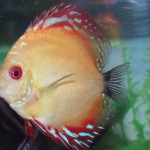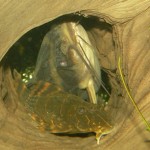The Crystal Red Shrimp is not at all a difficult species to breed as some may believe.
Crystal Red Shrimp can breed just as readily as most other Caridina species. It will also produce just as many offspring given that the water is clean and the parameters are suited for this species.The babies of the Crystal Red Shrimp are colored just like their parents just after hatching. However, the grading of the offspring cannot be performed until they grow more. You will see the red/white coloration in the Crystal Red Shrimp Offspring but not any detailed features/patterns which can differentiate between grades.
Crystal Red Shrimp is a severely inbred species and obtaining higher grades means that breeders will produce offspring from the same genetic strain. Due to the overbreeding the Crystal Red Shrimp can be more delicate and succeptable to diseases as well as slight changes in water conditions as mentioned in the care section. Photo of a baby Crystal Red Shrimp below.
Sexing
When attempting to understand the reproduction process one of the most important aspects is the ability to sex the shrimp.
Age: Sexing of course depends on the age. Trying to sex adults is a lot easier than attempting to sex juvenile shrimp. Juvenile shrimp can be next to impossible to sex. Sexing sub-juvinile shrimp will most likely be impossible due to the fact that the shrimp is not old enough to display any gender identifying attributes. It is definitely a good idea to only attempt to sex adults.The difference in sex is quite obvious in adult animals, especially if one can compare male and female.
Size & Coloration: Adult females are 10-30% larger than adult males. Females have substantially larger scales on the abdomen also, the female is sometimes more robust in coloration.
Gender Attributes: There are also other methods to easily sex a shrimp. Certain identifiers, or attributes, can differentiate a male from a female without question. Some of these attributes also occur at certain periods whereas some with appear at all times. Of course a female currently holding eggs will tell you that it is indeed a female. However, when eggs are not present there are other ways to tell.
The “Saddle”: Once of the most common and distinguishable attributes is the appearance of a “saddle” or miniature undeveloped eggs in the ovaries. The term “saddle” comes from the fact that that the undeveloped eggs appear on the back of the shrimp, behind the head, which looks like the saddle on a horse. One of the few recognizable characteristics of young females, is the presence of “Saddle” before their first spawn.
Curved Underbelly: Another way to tell the difference between a male and a female is the appearance of a curved underbelly, or the region underneath the tail. When the female is pregnant the underbelly acts as a defense against potential damage to the eggs.
Mating
The “Act”: Mating between a male and female shrimp happens extremely fast. In a matter of seconds the male latches onto the female abdomen to abdomen, deposits his sperm, and quickly then releases the female. Sometimes you can actually observe a male constantly harrassing a female in an attempt to grab onto her. Next time you think that the shrimp are fighting it may be a male trying to mate instead.
Fertilization: As discussed earlier in the article the female contains tiny undeveloped eggs in the ovaries, also known as the “saddle”. The male deposits the sperm into the female before the eggs are passed from the ovaries and into the undercarriage. As the eggs are passed down into the undercarriage they become fertilized by the previously deposited sperm. There is a big misconception that the eggs are fertilized after they appear in the undercarriage which is untrue. You will not see a female mate if eggs are present, you will only see a female mate when eggs are not present. It is believed that the male has a tiny “appendage” that it uses to deposit the sperm into the female.
It is also believed that shortly after molting the female is ready to mate. The way in which the male knows that the female is ready to mate is unknown. Perhaps she releases a chemical signal or some other type of notification that only shrimp can detect. It is known though that when a female molts the males in the tank will swim around the tank in a drunken manner looking to find the ready female. When you see a bunch of shrimp swimming around in the tank against the glass make sure to sex the shrimp first. If you look closely you may notice that they are all males. If that is the case then everything is ok, they are just looking to mate.
Pregnancy
Berried: A female shrimp is of course officially pregnant when the eggs are present. Sometimes the term “berried” is used to signify that the female is holding eggs, the eggs being the “berries”. As stated before, once the eggs are present then they are officially fertilized. If the eggs have not hatched then the baby shrimp is not fully developed. If eggs have been dropped or it appears that the female has lost some eggs there can be many reasons for this. Some believe that young females that become pregnant for the first time are “amateurs” and will tend to drop some eggs. Others believe that when a female is unhealthy or unhappy then she will also drop some eggs. Also, it is believed that the older a female becomes the more eggs she can carry. All of these theories may be true. It is known though that when the conditions are right and the female is happy then she can constantly breed around the clock, hatching and once again becoming pregnant a few days later.
Egg Development: Egg coloration is brown and they take 3-4 weeks to hatch. A female will cary anywhere from 10 to 30 eggs.
Hatching
Newborn Shrimp: The actual hatching of the shrimp is extremely fast. The baby shrimp seems to pop out of the egg in under a second and latches onto the first thing it can find, typically a plant like moss. People that have observed the actual hatching say that the baby shrimp seem to fly out of the belly of the female. Some have even said that the female seems to assist the babies out by “kicking” them or giving them a nudge. It is very rare to observe the actual hatching of a shrimp. The females tend to hide and the hatching may even occur at night.
















